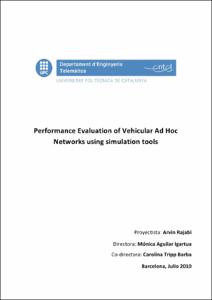Mostra el registre d'ítem simple
Performance Evaluation of Vehicular Ad Hoc Networks using simulation tools
| dc.contributor | Aguilar Igartua, Mónica |
| dc.contributor.author | Rajabi Tari, Arvin |
| dc.contributor.other | Universitat Politècnica de Catalunya. Departament d'Enginyeria Telemàtica |
| dc.date.accessioned | 2010-10-04T15:08:01Z |
| dc.date.available | 2010-10-04T15:08:01Z |
| dc.date.issued | 2010-07 |
| dc.identifier.uri | http://hdl.handle.net/2099.1/9809 |
| dc.description.abstract | Recent studies demonstrate that the routing protocol performances in vehicular networks can improve using dynamic information on the traffic conditions. WSNs (Wireless Sensor Networks) and VANETs (Vehicular Ad Hoc Networks) are exactly related with this statement and represent the trend of wireless networks research program in the last years. In this context, a new type of network has been developed: in fact, HSVN (Hybrid Sensor and Vehicular Network) let WSNs and VANETs cooperate through dynamic information data exchanges with the aim to improve road safety, and especially to warn the driver and the co-pilot of any event occurred in the road ahead, such as traffic jam, accidents or bad weather. The results will be immediate: less accidents means more saved lives, less traffic means a pollution decrease, and from the technological point of view, this communication protocol will open the door to attractive services, such as downloading of multimedia services or internet browsing, that means easier, safer and more comfortable trips. It is out of doubt that speaking about cars and road technology developments, the market and the interests about this field increase exponentially. Recent projects such as CVIS [1] and COMeSafety [2], focused on improving the road driving, and are the concrete demonstration that this entire context can get soon very close to reality. Owing to their peculiar characteristics, VANETs require the definition of specific networking techniques, whose feasibility and performance are usually tested by means of simulation. Starting from this point, this project will present a HSVN platform, and will also introduce and evaluate a communication protocol between VANETs and WSNs using the NCTUns 6.0 [3] simulator. We will particularly analyze the performances of 2 types of Scenarios developed during our project. Both of them are in an urban context, but we will extract different useful results analyzing the packet losses, the throughput and the end-to-end packet delay. |
| dc.language.iso | eng |
| dc.publisher | Universitat Politècnica de Catalunya |
| dc.rights | Attribution-NonCommercial-NoDerivs 3.0 Spain |
| dc.rights.uri | http://creativecommons.org/licenses/by-nc-nd/3.0/es/ |
| dc.subject | Àrees temàtiques de la UPC::Enginyeria de la telecomunicació::Telemàtica i xarxes d'ordinadors::Xarxes d'àrea local |
| dc.subject.lcsh | Ad hoc networks (Computer networks) -- Case studies |
| dc.subject.other | VANET's |
| dc.subject.other | Vehicular ad Hoc Networks |
| dc.title | Performance Evaluation of Vehicular Ad Hoc Networks using simulation tools |
| dc.type | Master thesis (pre-Bologna period) |
| dc.subject.lemac | Xarxes ad-hoc -- Estudi de casos |
| dc.rights.access | Open Access |
| dc.audience.educationlevel | Estudis de primer/segon cicle |
| dc.audience.mediator | Escola Tècnica Superior d'Enginyeria de Telecomunicació de Barcelona |
| dc.audience.degree | ENGINYERIA DE TELECOMUNICACIÓ (Pla 1992) |


